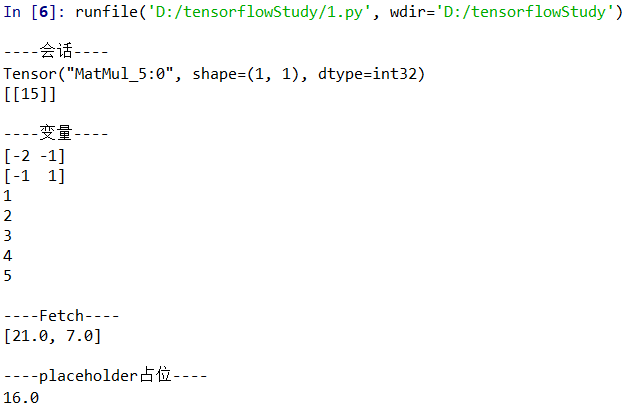一、Tensorflow基本概念
1、使用图(graphs)来表示计算任务,用于搭建神经网络的计算过程,但其只搭建网络,不计算
2、在被称之为会话(Session)的上下文(context)中执行图
3、使用张量(tensor)表示数据,用“阶”表示张量的维度。关于这一点需要展开一下
0阶张量称为标量,表示单独的一个数
1阶张量称为向量, 表示一个一维数组
2阶张量称为矩阵,表示一个二维数组
……
张量是几阶的可以通过张量右边的方括号数来判断。例如 t = [ [ [ ] ] ],显然这个为3阶。
4、通过变量(Variable)维护状态
5、使用feed和fetch可以为任意的操作赋值或者从其中获取数据
Tensorflow是一个编程系统,使用图(graphs)来表示计算任务,图(graphs)中的节点称之为op(operation),一个op获得0个或者多个Tensor,执行计算,产生0个或多个Tensor,Tensor看作是一个n维的数组或列表。图必须在会话(Session)里被启动。
二、tensorflow基本框架知识
# -*- coding: utf-8 -*- import tensorflow as tf print(" ----会话----") m1 = tf.constant([[3, 3]])#一行两列的矩阵,这里是矩阵乘法,所以是二维数组,注意书写格式以及矩阵乘法规则 m2 = tf.constant([[2], [3]])#两行一列的矩阵 product = tf.matmul(m1, m2)# 创建一个矩阵乘法(matmul)的op print(product) # sess = tf.Session() # result = sess.run(product) # print(result) # sess.close() with tf.Session() as sess: result = sess.run(product) print(result) print(" ----变量----") x = tf.Variable([1, 2])# 定义一个变量,这里是张量的加减法,所以一维数组即可 a = tf.constant([3, 3])# 定义一个常量 sub = tf.subtract(x, a)# 增加一个减法op add = tf.add(x, sub)# 增加一个加法op init = tf.global_variables_initializer() # 在tensorflow中使用变量要初始化,此条语句也可以初始化多个变量,这句代码提示没有(),多加练习 with tf.Session() as sess: sess.run(init) print(sess.run(sub)) print(sess.run(add)) a = tf.Variable(0, name='counter')# 创建一个变量初始化为0,并命名为counter。(此段代码中命名无作用) add = tf.add(a, 1) update = tf.assign(a, add) # 赋值 init = tf.global_variables_initializer() with tf.Session() as sess: sess.run(init) for i in range(5): print(sess.run(update)) print(" ----Fetch----") #sess.run([fetch1,fetch2]) 进行多个op,注意格式 input1 = tf.constant(3.0) input2 = tf.constant(2.0) input3 = tf.constant(5.0) add = tf.add(input2,input3) mul = tf.multiply(input1, add) with tf.Session() as sess: result = sess.run([mul, add]) print(result) print(" ----placeholder占位----") a1 = tf.placeholder(tf.float32) a2 = tf.placeholder(tf.float32) output = tf.multiply(a1, a2) with tf.Session() as sess: print(sess.run(output,feed_dict={a1:8.0, a2:2.0}))
